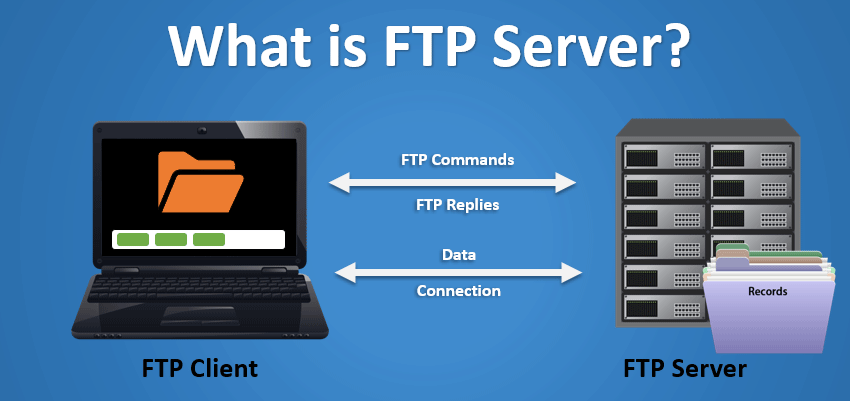FTC disclaimer: This post contains affiliate links and I will be compensated if you make a purchase after clicking on my link.
File Transfer Protocol (FTP) is a way to transfer files from one computer to another. It was originally designed as a replacement for email attachments but has since evolved into powerful tool webmasters use to upload content to websites.
In this tutorial, we’ll learn everything you need to know about FTP, including its history, benefits, limitations, and security concerns. We’ll also look at several popular FTP clients and see how each works.
If you’ve never heard of FTP before, you might not realize just how useful it can be. But once you understand the basics, you’ll wonder why you didn’t already use it.
What is FTP?
FTP stands for File Transfer Protocol. This protocol allows you to send files across a network like the Internet.
You use it to upload information from one place to another. You can download information just as easily.
The most common way to do this is to connect to a website, such as www.google.com, and type in a URL address.
You’d enter the URL into a browser window and press Enter. Then, you’d see the web page that Google pulled up.
If you want to look something up online, you’ll probably use a different method. But, sometimes, you might want to pull up a file on someone else’s computer.
To do this, you’d use FTP. To start, you’d log onto a website like ftp.cnet.com. Once logged in, you’d select “Connect.”
A box would pop up asking what you want to do next. Select “Transfer Files,” and you’re ready to begin.
Once you’ve connected both computers, you can choose where to put the file. On Windows systems, you’d drag and drop the file from your desktop to the folder on the server.
Then, you’d enter the IP address of the computer hosting the file. After that, you’d click OK.
Now, you can browse around the server and pick the file you want to copy. Return to your original computer and delete the file when you’re done.
There are many FTP clients out there. Some examples include WinSCP, Cyberduck, Putty, FileZilla, and WinZip.
Understanding FTP connection
In the early days of computers, there were no easy ways to connect multiple machines together.
Connecting one computer to another requires a lot of technical know-how. This meant you had to either learn it yourself or hire someone else to do it for you.
If you wanted to connect two different computers together, you needed something called a network adapter. These adapters allowed you to plug a cable into each machine and then use software to talk to each other over a local area network (LAN).
The most common type of LAN connection used today is Ethernet networking. This technology uses twisted pair copper wire cables to transmit signals and is widely used throughout homes and offices.
However, Ethernet networking requires special hardware, such as switches, hubs, and routers, because it operates on a physical rather than a logical layer.
A newer networking standard, TCP/IP, allows computers to communicate with each other regardless of their plugged equipment.
This is accomplished by converting information into packets and sending those packets across a network.
To send a packet, a device must have both a destination address and a source address. All devices on the same network have the same IP addresses; however, each has a unique MAC address.
Each packet contains a header with the source and destination addresses and the payload’s length.
When the packet arrives at its destination, the receiving device strips off the header and sends the packet to the appropriate application program.
To ensure messages arrive safely, protocols like FTP require two separate communication paths.
One path controls the conversation between the client and the server. The second path is used for transferring the actual file.
Both paths must be open during a session. For example, if a user wants to download a file, he or she must initiate a conversation with the server.
Once the conversation begins, the user can start downloading the file.
How does FTP work?
FTP protocol allows you to transfer files over the Internet from one computer to another. You don’t need to download anything; just upload what you want to send.
The most popular way to use FTP is via FileZilla software. When you start uploading something, you must provide username and password information.
These credentials allow the program to connect to the remote server. Once connected, it sends instructions to the remote server telling it how to handle the uploaded data.
After receiving the instructions, the server responds with the requested data.
There are two different ways to initiate an FTP session. One is called passive mode, and the other is active mode.
In passive mode, the client connects to the server without prompting login information. However, in active mode, the client prompts for the username and password information.
In the first method, you use the username and password to log into the server. Once logged in, you send commands to initiate file transfers.
The second way to connect to an FTP server uses the passive mode. You provide the server’s IP address and port number in this case.
Then, the server responds with a welcome message and asks for authentication information.
After receiving the credentials, the server sends the directory listing and closes the connection.
The basic steps involved in an FTP transaction include the following:
- An FTP session begins when a client sends a request to connect to a server. This is usually done via a network connection such as a modem or router.
- After establishing a connection, the client issues a list of commands to instruct the server on what it wants to do. Commands are sent over the command channel.
- Once the client receives confirmation that the server understands the commands, it uses the data channel to send information about the files it wishes to access.
- The server responds to each command with a status code indicating whether it understood the command or not. The server returns an error code if it doesn’t understand the command.
- When the client finishes sending its file listing, it closes the connection.
Understanding Active FTP and Passive FTP connection
Clients open ports and listen for incoming connections in an Active FTP connection. When one is established, they send data to each other.
This allows you to transfer files quickly. However, there are some drawbacks.
For example, if someone else uses the same port number, you won’t know about it unless you monitor it.
Also, if you want to connect to another computer, you’ll need to use the IP address rather than the hostname.
Passive FTP works differently. A server opens a port and waits for clients to connect to it. Clients initiate the connection and give information such as file names, sizes, and types.
The servers respond with the requested information. This method provides security because no one knows what request you’re sending. But it takes longer to set up a connection, and transfers take much longer.
Which two ports are used in FTP?
FTP stands for File Transfer Protocol. This protocol allows you to copy files and folders between computers over a Local Area Network (LAN). In addition to transferring files, it also supports remote access, such as downloading files from a website.
By default, two ports, 20 (data port) and 21 (command port), are used, a data and a command port, respectively.
Port number 20 is a data port used for file transfers between the server and the clients. Port number 21 is a control port that sends control messages and receives related FTP commands from clients.
An FTP (or FTP) program allows computers to communicate with each other by sending files back and forth between them. It works similarly to email, but instead of using an email address, you use an IP address.
According to the TCP provision, FTP servers usually assign well-defined ports for sending their responses back to the client. Clients usually assign a temporary port number to request from the FTP server.
FTP Servers vs. Cloud FTP Solutions
The popularity of cloud computing continues to grow, offering businesses a viable option for many applications.
File Transfer Protocol (FTP), one of the most popular protocols for file transfers across networks, is still widely used throughout enterprises.
But with the rise of cloud-based file storage and collaboration tools, companies are increasingly looking into moving away from FTP servers.
Though FTP (File Transfer Protocol) has long been used to transfer files across networks, newer file-sharing services such as Google Drive and Dropbox allow users to collaborate on documents and securely share large amounts of data online.
In addition, both cloud platforms and FTP servers provide secure connections for file transfer, though FTP servers cannot track down who accessed the information. In contrast, cloud-based solutions allow you to monitor usage and report incidents.
With the growing number of threats targeting cloud-based environments, however, organizations must weigh the pros and cons of each solution carefully before making a decision.
What’s the Difference between FTP and HTTP?
FTP stands for File Transfer Protocol. This protocol was developed to allow people to send files over networks. When you use FTP to connect to a website, you connect to an FTP server.
An FTP server is a computer that stores information about what files are located on the network. You can access those files by downloading them through FTP.
HTTP is the Internet standard for transferring documents and media files. A browser uses HTTP to communicate with servers on the World Wide Web.
To display a webpage, a browser must know how to find the HTML code document. If you type “www.google.com” into your address bar, a browser requests the IP address associated with www.google.com. When the server receives the request, it sends back the requested file.
The difference between FTP and HTTP is that HTTP is used to retrieve data from a website, while FTP is used to upload data to a website.
Why is FTP not secure?
FTP is an insecure protocol and should not be used to transfer sensitive data.FTP is an old protocol developed long before security was a concern on the Internet.
The protocol was designed for simplicity and ease of use, and as a result, it lacks many of the security features common in modern protocols.
FTP is an unencrypted protocol, meaning all data transferred using FTP is sent in plain text. This includes usernames, passwords, and the data itself.
Anyone who can intercept the traffic between the FTP server and the client can easily read the data.
FTP supports many insecure features, such as anonymous login and clear text commands.
Anonymous login allows anyone to log in to the FTP server without a username or password. This can be a security risk if the FTP server is misconfigured and allows anonymous users to access sensitive files.
Clear text commands are commands sent in plain text without encryption. If someone can intercept the traffic between the FTP server and the client, they can see the commands being sent and potentially execute them.
There are many more secure alternatives to FTP that should be used instead. SFTP (Secure File Transfer Protocol) and FTPS (File Transfer Protocol over SSL) are more secure alternatives that provide encryption and authentication.
If you must use FTP, there are a few things that you can do to reduce the risks. Use a VPN (Virtual Private Network) to encrypt the traffic between your computer and the FTP server. Additionally, use SFTP or FTPS instead of FTP whenever possible.
Finally, ensure you are using strong passwords and only sharing files with people you trust.
5 Best FTP Clients You Should Know
There are a few different types of FTP clients, each with its own features and capabilities. In this section, we’ll look at some of the best FTP clients available, so you can decide which one is right for you.
So, what are some of the best FTP clients out there? Here are a few of our favorites:
FileZilla:
FileZilla is a free, open-source FTP client for Windows, Mac, and Linux. It’s a great choice for beginners because it’s easy to use and has many features.
FileZilla includes a graphical user interface (GUI) and a command line interface (CLI), so you can use it regardless of your experience level.
It also supports many features, including file encryption, automatic file transfer resuming, and more.
CyberDuck:
CyberDuck is another free, open-source FTP client. It’s available for Windows, Mac, and Linux, and it’s a great choice for both beginners and advanced users.
CyberDuck has a clean, easy-to-use interface and supports many features. It can encrypt your files, resume interrupted transfers, and more.
WinSCP:
WinSCP is a free FTP client for Windows. It has a clean, easy-to-use interface and supports a wide range of features. It can encrypt your files, resume interrupted transfers, and more.
WinSCP is a great choice for both beginners and advanced users.
FTP Voyager:
FTP Voyager is a commercial FTP client. It’s available for Windows and Linux.
FTP Voyager is a great choice for both beginners and advanced users. It has a clean, easy-to-use interface and supports a wide range of features. It can encrypt your files, resume interrupted transfers, and more.
Core FTP:
Core FTP is a free, open-source FTP client. It’s available for Windows, Mac, and Linux.
Core FTP is a great choice for both beginners and advanced users. It has a clean, easy-to-use interface and supports a wide range of features. It can encrypt your files, resume interrupted transfers, and more.
Which FTP Client Is Right for You?
Now that you know a bit about FTP and some of the best FTP clients, it’s time to choose the right one.
If you’re a beginner, we recommend FileZilla or CyberDuck. If you’re an advanced user, we recommend WinSCP or FTP Voyager.
No matter which FTP client you choose, make sure you take the time to learn how to use it. FTP can be tricky, and the more you know about it, the better.
Conclusion
FTP is a protocol that enables two computers to transfer files. It is a client-server architecture where a server stores files and a client accesses and retrieves them.
FTP is a simple and efficient way to move large amounts of data between computers.














